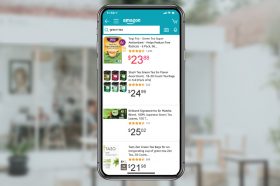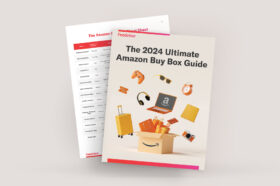Resources - Blog
Amazon Pricing Strategies Beyond the Buy Box [Webinar Recap]

Stay on top of the latest e-commerce and marketplace trends.
Product prices are among consumers’ biggest draw to shopping on Amazon’s marketplace. A whopping 82% of consumers say price is a very important factor when selecting a product on Amazon, according to Feedvisor data. Likewise, 82% of consumers also say they go to Amazon to check product prices prior to making a purchase decision.
Indeed, sellers and brands know they need a competitive pricing strategy to win conversions on the platform. In fact, 51% of brands on Amazon say competitive pricing is the most effective strategy that they leverage to drive sales.
In this webinar, former Amazonian Andrea Riposati, founder and CEO of Dante Labs, breaks down the fundamentals of pricing on Amazon, including the economics and their impact on Amazon’s search results page. He also outlines the differences between revenue- and profit-focused business objectives, emotional versus economic goals, and pricing strategies beyond the Buy Box to maximize profits, revenue, and demand.
There are no good or bad products. There are only bad prices.
The Fundamentals of Pricing on Amazon
To begin, Andrea notes that, too often, sellers and brands on Amazon approach pricing from an emotional perspective rather than with a rational, scientific objective. An excellent, high-quality product set at too high of a price can result in failure while, on the other hand, a cheap, low-quality product sold at a great price, despite its quality, can be a huge success.
While the majority of available pricing resources for sellers revolve around winning the Buy Box, the prices of your products greatly impact other various aspects of your seller performance. Firstly, your product’s price is a key driver of your revenue and profits or your demand curve. What this means, Andrea explains, is that a product sold at a higher price leads to a lower quantity of units sold, resulting in lower revenue, which is calculated by multiplying your price by the quantity sold.
In regard to the demand curve, one benefit to selling on Amazon is the amount of traffic that visits the platform and, ultimately, orders your product. The more orders you fulfill, the more you can experiment with different price points over time to determine their impact on your demand — essentially developing your demand curve — which will allow you to understand the price points that will maximize your revenue.
Andrea also explains that different price decisions could lead to the same revenues but different profits. An item that is sold at a higher price point but at a lower quantity will have a higher profit than that same item sold at a lower price point at a greater quantity. As such, it is crucial that you determine your prices scientifically, with a revenue- or profit-focused strategy in mind, to ensure that you achieve your business goals.
Evolution of the Approach to Pricing
Next, Andrea outlines the evolution that each Amazon seller should go through in terms of their approach to pricing in which the obvious first approach is leveraging pricing as a driver to winning the Buy Box.
The next approach is to think about pricing as a way to win against competitors, both direct and indirect — not only those who you are competing against for Buy Box share but also competitors who are selling products similar to yours and are stealing demand from you. For instance, if you are a private label brand selling a water bottle, you might not be competing for the Buy Box on that specific ASIN, but you will have to price your water bottle against your competitors selling similar water bottles.
All of these factors and approaches to pricing will have a significant impact on your key performance indicators (KPIs), including:
- Number of units sold
- Revenue
- Profits
- Best Sellers Rank
- Quality perception
- Perception vs. other competitors
- Share of the customer’s disposable income
How to Move the Demand Curve on Amazon
Different KPIs will have a different impact on the direction of your demand curve, Andrea explains. To move the demand curve positively means that with the same price, you will sell more units. Conversely, to move the demand curve negatively, it means that you will sell less units with the same price.
Certainly, your goal will be to positively move the demand curve, which can be achieved by the improvement of various KPIs such as increasing your average seller rating and number of reviews to help increase your rank on Amazon’s results page.
Additionally, Andrea explains that your goals can be strategic, such as maximizing revenue and profits, or they can be tactical, like stealing demand from a competitor by increasing your sales. However, your goals should never be based on emotion. For example, some sellers might feel pressured to run a back to school promotion simply because other sellers are doing so, but if your goal is to maximize profits, a promotion will prevent you from achieving that objective.
Final Thoughts
As any seasoned Amazon seller or brand knows, there is more to pricing on Amazon than strictly winning the Buy Box. Nearly half (44%) of consumers do not go past the second page of search results on Amazon and 26% say they frequently buy the first product listed on an Amazon results page.
The prices that you set for your products not only determine your Buy Box share but also greatly impact your search rank, conversion rate, and overall sales performance. To win on Amazon’s marketplace, you must employ a dynamic pricing strategy based on economic goals to climb the Amazon’s Best Sellers Rank, maximize profits and revenue, and steal demand from your competitors to win on the platform.
Learn what Feedvisor can do for your business.
When you partner with Feedvisor, you automatically receive access to our true, AI-driven technology and hands-on team of e-commerce experts. Contact one of our team members today to learn more about our end-to-end solution for brands and large sellers on Amazon, Walmart, and e-marketplaces.




